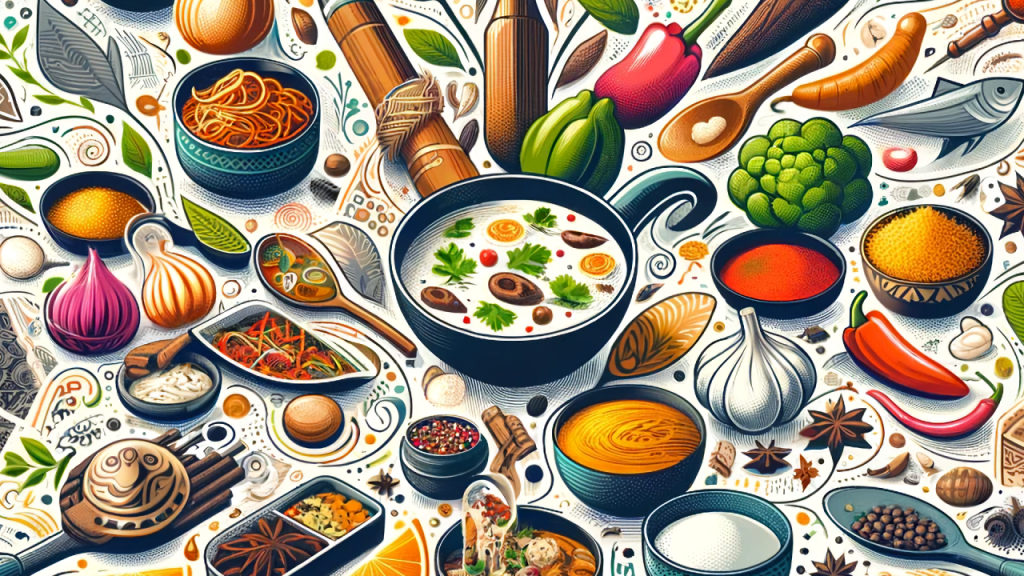Fusion cuisine is an innovative and exciting approach to cooking that blends ingredients, techniques, and flavors from different culinary traditions. When cultures collide on the plate, the result is a harmonious mixture of tastes that challenges the boundaries of traditional cooking while offering a fresh perspective on food. Whether it’s a taco with sushi ingredients or a pasta with a spicy Asian twist, fusion cuisine brings a world of flavors together. In this article, we’ll explore the origins of fusion cuisine, the key principles behind it, and how to experiment with your own fusion dishes.
What is Fusion Cuisine?
Fusion cuisine is the art of combining elements from different culinary traditions to create something new. The concept emerged as global travel, cultural exchange, and migration led to more diverse communities, where different foods and cooking methods converged. Over time, chefs began experimenting with these new flavors and ingredients, blending them to create innovative dishes.
While some view fusion cuisine as a modern trend, its roots can be traced back centuries. For example, the Silk Road, which connected Asia, the Middle East, and Europe, facilitated the exchange of spices and cooking techniques long before the term “fusion cuisine” became popular.
Today, fusion cuisine is seen in many restaurants worldwide, where chefs are free to mix and match ingredients and techniques from different parts of the world. The result is not only a more diverse dining experience but also an opportunity to challenge the norms of traditional cuisine.
The Principles of Fusion Cuisine
To successfully create fusion dishes, there are a few important principles to follow. Understanding these can help you develop your own fusion creations with balance and flavor:
1. Respecting the Core Flavors of Each Cuisine
While fusion cuisine encourages experimentation, it’s important not to lose sight of the flavors that define each culture’s food. When mixing ingredients or techniques from different culinary traditions, the key is to respect the fundamental tastes of each cuisine. For instance, Italian cuisine is known for its use of fresh herbs and rich cheeses, while Indian cuisine is defined by its bold, spiced flavors. The challenge is blending these ingredients in a way that allows each culture’s essence to shine through.
2. Balance is Key
One of the main challenges of fusion cuisine is achieving balance. A dish that combines too many bold, conflicting flavors can feel chaotic and overwhelming. The trick is to select flavors that complement each other while still offering contrast. For example, pairing the rich, creamy textures of French cuisine with the bright acidity of Mexican lime or adding a touch of umami from Japanese miso to an Italian pasta can create balance and excitement in the dish.
3. Experimenting with Ingredients
Fusion cuisine often involves swapping traditional ingredients for unexpected ones. For instance, using plantains instead of potatoes, or adding kimchi to a grilled cheese sandwich, creates an interesting twist on a familiar dish. This fusion of ingredients helps give classic recipes new life and encourages diners to experience food in novel ways.
4. Techniques and Cooking Methods
Fusion doesn’t only apply to ingredients. Cooking techniques from different cultures can also be combined. Think of grilling meats in the Korean barbecue style, but adding them to a traditional American BBQ plate, or using a French sous-vide technique to cook a Japanese dish. These techniques not only elevate the dish but also combine the best of different culinary traditions.

Popular Examples of Fusion Cuisine
Fusion cuisine spans the globe, and chefs have come up with numerous inventive combinations. Here are some of the most popular fusion dishes:
1. Sushi Burrito
The sushi burrito is a perfect example of the melding of Japanese and Mexican cuisines. By wrapping sushi ingredients, such as raw fish, avocado, and rice, in a large seaweed sheet, and serving it burrito-style, this dish combines the freshness of sushi with the handheld convenience of a burrito. It’s an ideal on-the-go meal that captures the best of both cultures.
2. Korean BBQ Tacos
Korean BBQ tacos combine the savory, marinated meats of Korean barbecue with the portability and flavor of Mexican street tacos. The dish typically includes marinated bulgogi beef or pork, sautéed vegetables, kimchi, and a drizzle of spicy gochujang sauce, all wrapped in a soft corn tortilla. This fusion brings together the smoky, tender flavors of Korean BBQ with the fresh, zesty ingredients of Mexican cuisine.
3. Indian-Style Pizza
Indian-style pizza is a fusion of classic Italian pizza with the bold, aromatic spices of Indian cuisine. Instead of the traditional pizza toppings, you might find spiced chicken tikka, paneer (Indian cottage cheese), or even a tangy tamarind sauce. The Indian flavors mesh perfectly with the crispy crust, offering a completely new take on pizza.
4. Pad Thai Spring Rolls
This dish combines the beloved Thai street food, Pad Thai, with the freshness of Vietnamese spring rolls. The dish includes rice noodles, shrimp, peanuts, and a sweet-savory sauce wrapped in a rice paper roll. This fusion allows you to enjoy the flavors of Pad Thai in a lighter, more refreshing form.
5. Tex-Mex Sushi
Tex-Mex sushi takes the concept of sushi to new heights by incorporating traditional Mexican ingredients, such as avocado, jalapeños, and cilantro. Instead of using traditional sushi rice and seaweed, some variations of Tex-Mex sushi even swap them for tortillas and rice, resulting in a unique fusion roll that’s both comforting and flavorful.
How to Create Your Own Fusion Dishes
If you’re inspired by fusion cuisine and want to create your own combinations, here are some tips to help guide you:
1. Start with What You Know
If you’re new to fusion cooking, it’s a good idea to begin by taking familiar dishes and swapping out one or two key ingredients from a different culture. For example, try adding Thai basil and lime to a classic Italian pasta, or swap soy sauce for Worcestershire sauce in a steak marinade.
2. Think About Flavor Profiles
Different cuisines often have distinct flavor profiles. Consider combining flavors that complement each other. For example, French cuisine’s rich, buttery flavors can pair well with the fresh acidity of Mediterranean or Latin ingredients like citrus and tomatoes. Think about balancing savory, sweet, sour, and spicy flavors to create a harmonious dish.
3. Use Cross-Cultural Ingredients
Fusion cuisine often calls for cross-cultural ingredients. Experiment with using ingredients from one cuisine in a traditional dish of another. For instance, adding miso to a French onion soup can enhance its umami, or you could incorporate Middle Eastern spices like cumin and coriander into a classic American chili.
4. Don’t Be Afraid to Play with Presentation
Presentation is just as important as flavor in fusion cuisine. Think about blending the plating styles of different cultures to create an aesthetically pleasing dish. For example, you could arrange a Mexican-inspired dish on a traditional Chinese-style porcelain plate or serve sushi in a taco shell. This adds an extra layer of creativity to your fusion dish.

Challenges of Fusion Cuisine
While fusion cuisine offers endless possibilities for creativity, it does come with its own set of challenges. Some purists argue that fusion cuisine waters down the authenticity of traditional dishes, and when not done thoughtfully, it can result in confusing, unbalanced dishes. Additionally, sourcing authentic ingredients from various cultures can sometimes be difficult or expensive.
To overcome these challenges, focus on balance and respect for the original cuisines. Take the time to experiment, but always remember that good food is about more than just combining different ingredients—it’s about celebrating the flavors that each culture brings to the table.
Conclusion
Fusion cuisine is a celebration of diversity, offering an exciting opportunity to blend flavors, techniques, and ingredients from different parts of the world. It’s a way to reinvent traditional dishes, introduce new culinary experiences, and create something that’s both unique and delicious. Whether you’re enjoying a Korean BBQ taco or a sushi burrito, fusion cuisine invites you to step outside the box and explore the endless possibilities that exist when cultures collide on the plate. So, why not experiment in your own kitchen and see where your culinary creativity can take you?


